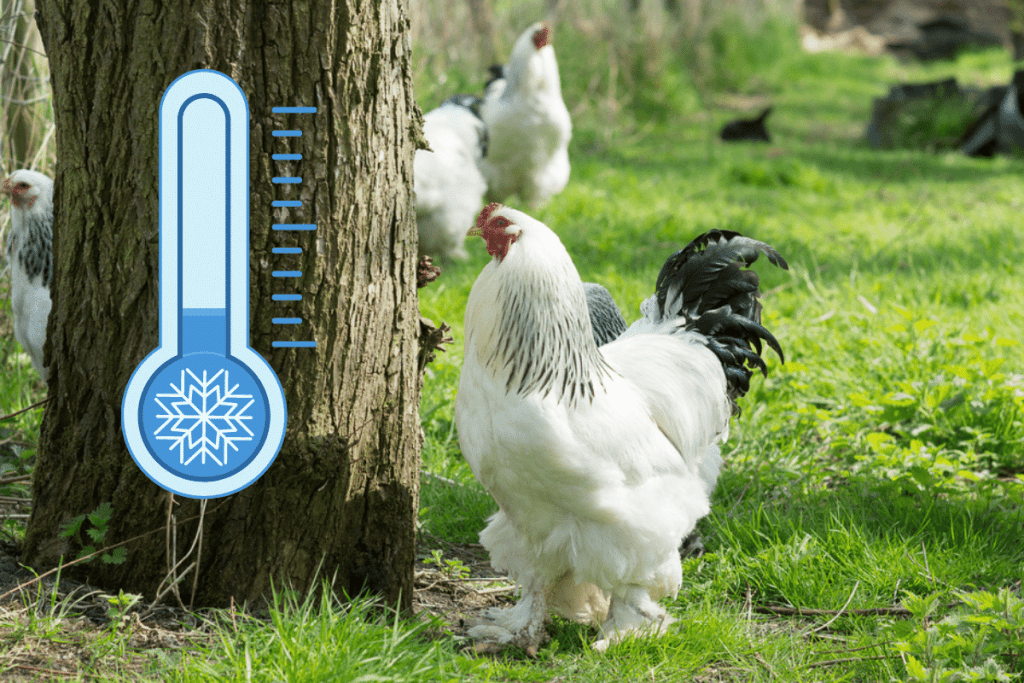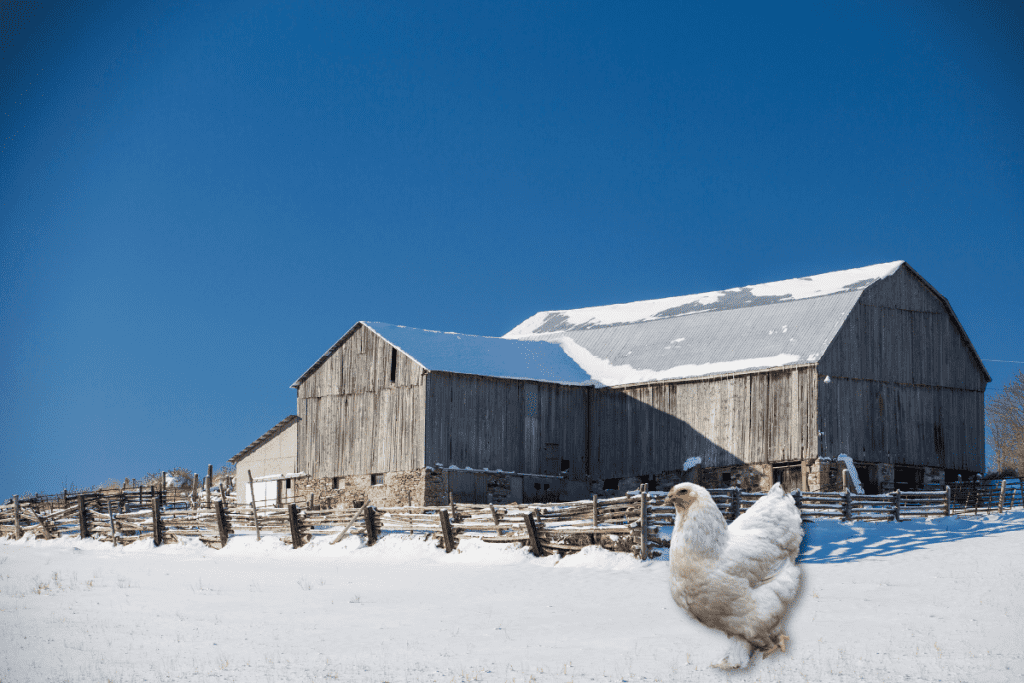Brahmas chickens are one of the largest poultry breeds in the world.
A Brahma hen weighs between 8-9 pounds, and the roosters average between 10-12 pounds.
These chickens are called “gentle giants” because of their friendly personalities and gigantic size.
The Brahma chicken is a cold-tolerant poultry breed, and in addition to the feathers on the body, it also has dense foot feathers.
The Brahma’s large size and feathered feet help protect it against cold temperatures.
But what are the lowest temperatures this bird can tolerate?
The lowest temperatures a Brahma chicken can withstand are around or slightly below 32° degrees Fahrenheit (0° C). Brahmas will tolerate freezing temperatures as long as they are kept dry and fed a quality, high-calorie diet.
Even though Brahmas do well in cold climates, they still need a properly winterized chicken coop to sleep in at night.
Snow must also be cleared from the chicken run to keep the Brahma’s fluffy legs dry and protect it from frostbite.
Read on to learn more about cold-hardy chicken breeds and how to care for Brahmas during the harsh winter months.

Table of Contents
ToggleWhat Do Cold-Hardy Chicken Breeds Have in Common?
Cold climate chicken breeds have several things in common to help them withstand the colder months.
Brahmas and other cold-hardy chicken breeds are typically larger than the average chicken.
They use their extra fat stores to survive the winter.
Some regular-sized chickens can adapt to colder weather but prefer warmer temperatures.
Bantam poultry breeds are too small to deal with freezing temperatures for an extended period unless they have dense feathering.
Cold weather chickens also have dense, warm feathers all over their bodies.
This shields them from their cold environment and protect them against frostbite.
The birds will fluff up their dense plumage to warm up when they feel a chill.
A few cold-weather breeds, such as the Brahma, Cochin, and Faverolle, have foot feathers.
This dense foot feathering helps keep the feet warm but might be an issue in muddy winters.
It is crucial to keep the feathered feet of these birds clean and dry to prevent frostbite.
Winter hardy birds also tend to huddle together in the coop to maintain body heat in colder climates.
The combs and wattles of cold-weather chickens are smaller than warm-weather breeds.
These parts make these areas without dense feathering less susceptible to frostbite.
Do Brahmas Lay Eggs in the Winter?
Brahmas are a dual-purpose breed, which is raised for meat and eggs.
This Brahma was initially raised as a meat bird because of its large size.
But then it was discovered this breed of chicken was also an excellent egg layer.
Unlike chicken breeds from warmer climates, Brahmas lay most of their eggs in cold temperatures.
Further Reading: Answers to all Brahma egg questions
Brahmas will lay eggs from October through May when other egg layers have decreased production.
Since Brahmas have such a friendly nature, these calm birds get along well with other breeds of chickens.
Add some prolific layers like Rhode Island Reds or Barred Plymouth Rocks to your Brahmas for a mixed flock if you want eggs year-round.
Both breeds are suitable for cold temperatures, but their peak egg production is usually during the warmer months.
Rhode Island Reds tend to be more aggressive than Barred Plymouth Rocks.
You may want to keep this in mind before adding them to your feathered family.
The Barred Plymouth Rock has a calm personality and friendly nature, so it may be a better match for the equally docile Brahma.
What to Do When Your Chickens Start to Freeze

The Brahma’s large size helps them do well during the cold winter.
However, these giant chickens may freeze in wet or muddy conditions for prolonged periods.
Baby chicks are particularly prone to freezing if proper measures are not taken to ensure they stay warm.
Some signs your chickens are too cold include:
- Ruffled feathers
- Pale comb or wattle
- Cold to the touch
- Perching on one leg
- Limpness
- Huddling together
If you notice these signs in your chickens or baby chicks, they need to be warmed up as soon as possible.
Place the chicken close to your body under your coat, or wrap them in warm towels to increase their body temperature.
If your entire flock of backyard chickens appears to be on the verge of freezing, you may need to move them into your garage, where it is warmer.
Use space heaters to keep the garage warm, and be sure to choose ones with safety features, so they will turn off automatically if they are accidentally knocked over.
Tips on Caring for Brahmas in Cold Weather
There are several tips to ensure the comfort and safety of your Brahmas during the winter.
Prevent Their Water from Freezing
Your chickens need constant access to clean, fresh water.
This is challenging during cold weather because the water for your chickens might freeze.
To keep the water from freezing, use a heated waterer whenever temperatures are 32° degrees Fahrenheit (0° C) or lower.
You may buy a heated base for your existing waterer or use one specially designed for freezing temperatures.
A waterer like this one on Amazon is highly recommended because of its large capacity, built-in thermostat, and no-roost design, which ensures clean water at all times.
Provide Extra Calories
Since your Brahmas will be using body fat to stay warm in a cold environment, providing them with more calories in their poultry feed makes sense.
Laying hens need extra calories to stay healthy throughout egg production.
Free choice feeding is essential during winter to ensure your chickens maintain their size and create enough body heat to digest their food properly.
You may also give your Brahmas extra treats in the evenings after they have received the nutrients from their poultry feed.
Scratch grains and suet are not as nutritious as poultry feed, but they provide the extra calories these active birds need to stay healthy during colder temperatures.
Brahmas eat about 170 grams of feed per day, and egg layers may need more calcium and protein supplements in addition to a high-calorie feed.
Letting your Brahmas roam free from time to time in the winter allows them to also forage for insects and get some exercise.
Keep the Bedding Clean and Dry
Replace the bedding and clean the entire coop once a week to prevent excess moisture and ammonia buildup.
If the bedding is moist, it increases the chance of your Brahmas developing frostbite and chicken diseases.
Too much ammonia from urine and bird poop will not only create a damp, cold environment but could cause lung issues in your chickens.
Another way to keep your chickens warm is to use the deep litter method.
This method involves adding fresh material to the old bedding to create a composting layer on the bottom.
The deep litter method produces heat; if done correctly, it will not add moisture to the chicken coop.
Winterize the Chicken Coop
The chicken coop needs the right ventilation to be comfortable for your chickens in the winter.
You do not want the coop to be too drafty and let cold air in; if it is sealed too much, moisture will be unable to escape.
Add plenty of ventilation near the top of the coop to allow moist air to flow out, and position the vents, so there is no cold air blowing on the roost where the birds sleep.
Prep the entire coop in the fall by thoroughly cleaning it and repairing any cracks or holes where cold air might blow through.
Add bales of straw next to the walls of the chicken coop to provide excellent insulation and give the Brahmas extra places to get off the ground.
Turn the straw bales sideways if there is not a lot of space in the coop.
Due to their gigantic size, Brahmas need a lot of room to move around freely.
Generally, you need at least 10′ square feet of space per bird in the coop and run.
Use Heat Lamps Carefully
Some backyard chicken keepers place heat lamps in their coops during the winter.
If you do this, you must be very careful to avoid starting a fire or causing injuries to your chickens.
Heat lamps are generally unnecessary, as the birds will huddle together at night and stay warm.
It is recommended to avoid heat lamps altogether to prevent a fire hazard.
Look for Signs of Frostbite
Regularly inspect your chickens for any signs of frostbite.
Brahmas have pea combs, so they are less prone to frostbite on their heads and faces than poultry breeds with rose combs.
However, with the dense feathering on their legs, Brahmas are more susceptible to frostbite on their legs and feet if their feathers get wet from mud or snow.
Keeping your Brahmas dry and maintaining proper ventilation in the coop will help prevent frostbite.
How useful was this post?
Click on a star to rate it!
We are sorry that this post was not useful for you!
Let us improve this post!
Tell us how we can improve this post?
